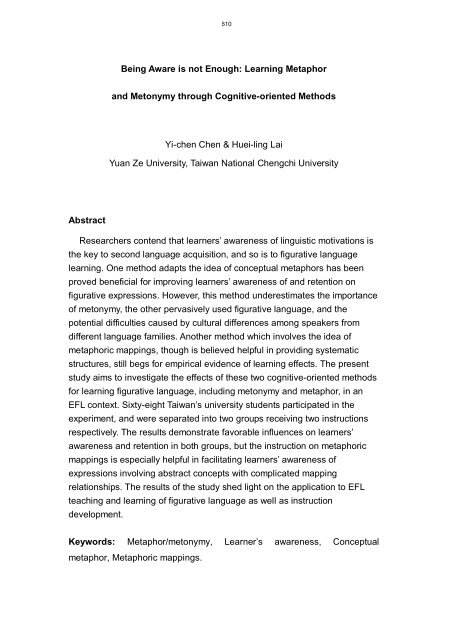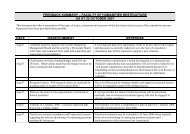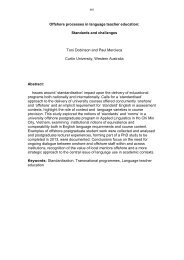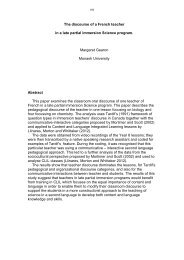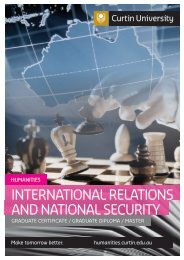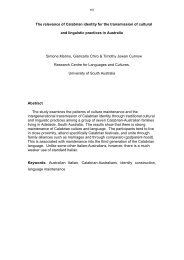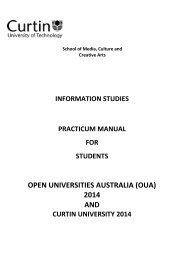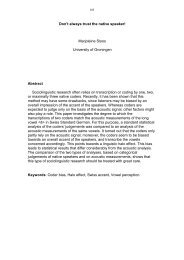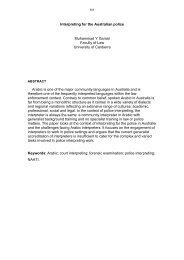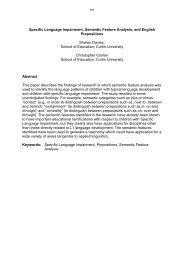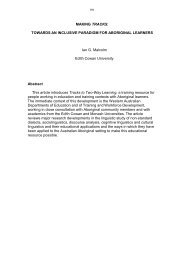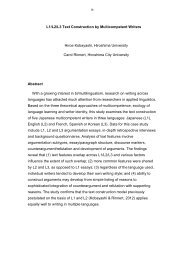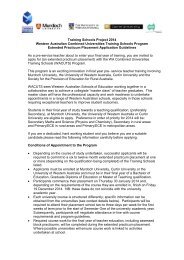Yi-chen and Huei-ling Lai - Humanities
Yi-chen and Huei-ling Lai - Humanities
Yi-chen and Huei-ling Lai - Humanities
- No tags were found...
You also want an ePaper? Increase the reach of your titles
YUMPU automatically turns print PDFs into web optimized ePapers that Google loves.
610Being Aware is not Enough: Learning Metaphor<strong>and</strong> Metonymy through Cognitive-oriented Methods<strong>Yi</strong>-<strong>chen</strong> Chen & <strong>Huei</strong>-<strong>ling</strong> <strong>Lai</strong>Yuan Ze University, Taiwan National Chengchi UniversityAbstractResearchers contend that learners’ awareness of <strong>ling</strong>uistic motivations isthe key to second language acquisition, <strong>and</strong> so is to figurative languagelearning. One method adapts the idea of conceptual metaphors has beenproved beneficial for improving learners’ awareness of <strong>and</strong> retention onfigurative expressions. However, this method underestimates the importanceof metonymy, the other pervasively used figurative language, <strong>and</strong> thepotential difficulties caused by cultural differences among speakers fromdifferent language families. Another method which involves the idea ofmetaphoric mappings, though is believed helpful in providing systematicstructures, still begs for empirical evidence of learning effects. The presentstudy aims to investigate the effects of these two cognitive-oriented methodsfor learning figurative language, including metonymy <strong>and</strong> metaphor, in anEFL context. Sixty-eight Taiwan’s university students participated in theexperiment, <strong>and</strong> were separated into two groups receiving two instructionsrespectively. The results demonstrate favorable influences on learners’awareness <strong>and</strong> retention in both groups, but the instruction on metaphoricmappings is especially helpful in facilitating learners’ awareness ofexpressions involving abstract concepts with complicated mappingrelationships. The results of the study shed light on the application to EFLteaching <strong>and</strong> learning of figurative language as well as instructiondevelopment.Keywords: Metaphor/metonymy, Learner’s awareness, Conceptualmetaphor, Metaphoric mappings.
612on the beneficial effects on L2 learners’ learning figurative expressions.Boers suggests that insightful L2 learning through the process ofunderst<strong>and</strong>ing semantic motivations behind expressions should beimplemented often in language classrooms (Boers & Lindstromberg, 2006).He defines the underlying motivation of figurative expressions as metaphorictheme, the structure <strong>and</strong> organization of the correspondence between thesource domain <strong>and</strong> the target domain (Boers, 2000a). In his study (2000b),L2 learners who were given explanations of figurative expressions in terms ofsource domains outperformed learners who received explanations offigurative senses of expressions in both an immediate comprehension test<strong>and</strong> a post-test given three days later. In another study (2000a), Boers foundthat learners who studied a list of words organized by metaphoric themeswere more likely to reproduce the expressions than learners who studied alist organized by traditional functional meanings. The findings support Boers’claim that providing metaphoric themes can enhance learners’ awareness ofnovel expressions <strong>and</strong> hence facilitate retention of the expressions.Despite the positive proof of the method, Boers’ method of providingconceptual metaphor as a trigger of learners’ awareness may be insufficientin some ways. First, the method focuses mainly on metaphor but seldom
613considers metonymy. Considering the intricate interactions betweenmetaphor <strong>and</strong> metonymy (Barnden, 2010; Goossens, 1990; Radden, 2003),as well as the various influences that metaphor <strong>and</strong> metonymy may presentto L2 learners (Chen & <strong>Lai</strong>, 2012), the underestimation of the importance ofmetonymy may lead to overlooking its effects on learning figurativeexpressions. In addition, the method focuses mainly on raising learners’awareness of semantic motivation but ignores possible gaps betweendifferent cultures <strong>and</strong> languages. Figurative language is rooted not only inlanguages but also in cultures <strong>and</strong> conventions (Kövecses, 2000); conflictsbetween L1 <strong>and</strong> L2 knowledge may cause great difficulties in learning(Kövecses, 2001). Finally, Boers’ studies are conducted primarily inEuropean countries; the participants’ native languages, such as French(Boers, 2000a, b) <strong>and</strong> Dutch (Boers, 2000a), were originated from alanguage family similar to English, meaning the differences between theircultures <strong>and</strong> languages were relatively smaller than between other languages.When considering learners of other native tongues, such as Chinese orJapanese learners whose native languages are relatively more different fromEnglish in origin <strong>and</strong> typology, difficulties caused by cultural gaps may be
614more serious. The question of whether the method could also be effective forthose learners is in need of further investigation.To bridge the methodological <strong>and</strong> pedagogical gaps existing in Boers’method, Kövecses (2001) proposed an alternative method, which was tointegrate metaphoric mappings in L2 learners’ learning process. Based onthe results of his small-scale study of Hungarian students learning Englishfigurative expressions, Kövecses (2001) speculated that metaphoricmappings not only can improve comprehension but also can facilitateproduction. If two languages have the same conceptual metaphor butdifferent <strong>ling</strong>uistic instantiations, ontological mappings that characterize thecorrespondences between basic constituent elements in the source domain<strong>and</strong> in the target domain may help learners to create links between distinct<strong>ling</strong>uistic expressions of the two languages. If two languages have differentconceptual metaphors, or if one language has a conceptual metaphor thatdoes not exist in the other language, epistemic mappings can provideknowledge about elements in the source domain to the target domain,helping learners to relate their knowledge of the used <strong>and</strong> abstract to theunused <strong>and</strong> concrete.
615The idea of using metaphoric mappings as explicit instruction not onlyfollows the trend of cognitive <strong>ling</strong>uistics, which values awareness <strong>and</strong>motivation, but also deals with possible <strong>ling</strong>uistic <strong>and</strong> cultural gaps by utilizinglearners’ already-existent world knowledge <strong>and</strong> universal concepts. Theadoption of metaphoric mappings, thus, seems to be promising in helpinglearners associate conceptual domains <strong>and</strong> finding the motivations ofexpressions. However, such idea has not yet been tested empirically. Withoutempirical evidence, the proposed method has not been able to claim itseffects on L2 learning.The present study, therefore, intends to evaluate the twocognitive-oriented methods in teaching Chinese EFL learners metaphoric <strong>and</strong>metonymic expressions, determine their effects on L2 figurative languagelearning, <strong>and</strong> find a compromising way to teach EFL learners who speakdifferent native languages. The two methods under investigation include themethod of conceptual metaphor (CM), 1 which focuses on providingconceptual metaphors so that learners can compare two domains to findassociative characteristics, <strong>and</strong> the method of metaphoric mapping (MM), 2which emphasizes mapping processes that learners can use to map betweendomains <strong>and</strong> between cultures. The present study targets native Chinese
616speakers who are learning English as a foreign language to investigate theirability to find figurative expressions <strong>and</strong> their retention of what they havelearned.METHODOLOGYParticipantsThe participants of the study were 68 first-year university students whowere non-English majors with levels of English proficiency ranging fromintermediate to high intermediate. They were all native Chinese speakers <strong>and</strong>had learned English for at least six years during their high school years; noneof the participants had lived in foreign countries for over one year. Thus, theyhad less experience of <strong>and</strong> exposure to English culture <strong>and</strong> authenticmaterials than English majors have. The control of the participants’ generalEnglish proficiency <strong>and</strong> experience in English is meant to mitigate the impactof factors identified as complicating in previous studies.The participants participated in two separate freshman English classes.Each class received one type of method: one class of 32 participantsreceived instruction in conceptual metaphors (the CM group), while the other
617class of 36 participants received instruction in metaphoric mappings (the MMgroup).InstrumentsTo measure the participants’ ability to recognize figurative language use,an awareness test was designed. The test consisted of 48 English sentencescollected from dictionaries, a corpus (the British National Corpus), <strong>and</strong> theInternet. The sentences were modified to maintain an average sentencelength of 10 to 15 words to ensure that the stimuli were similar <strong>and</strong> would notinfluence learners’ judgments. The sentences were also reviewed by nativeEnglish speakers to ensure their grammaticality <strong>and</strong> authenticity. In addition,the test items were pilot-tested twice for reliability <strong>and</strong> construct validity, <strong>and</strong>ambiguous or questionable items were removed.Among the 48 sentences, 24 sentences contained metaphoric ormetonymic expressions <strong>and</strong> the other 24 sentences were written with chosenkeywords or phrases from the sentences with metaphoric/metonymicexpressions <strong>and</strong> contained no figurative intentions in the expressions.Moreover, the sentences that had metaphoric or metonymic expressionswere further categorized into four groups based on the metonymy-metaphor
618continuum as shown in Table 1 (Chen & <strong>Lai</strong>, 2012): metonymy (C1),metaphoric-metonymy (C2), metonymic-metaphor (C3), <strong>and</strong> metaphor (C4).Participants were asked to read each sentence first <strong>and</strong> then determinewhether the sentence contained metaphoric/metonymic expressions, orwhether it needed to be understood by thinking figuratively. Participants wererequired to rate the certainty of their judgments on a scale of 1 to 5; to avoidreading problems caused by unknown vocabulary, one extra option (0) wasgiven as well. The average response of the participants would indicate theirability to find metaphors/metonymies.ProcedureThe experiment required two successive weeks to complete. The pre-test<strong>and</strong> teaching were conducted the first week, <strong>and</strong> the post-test was conductedthe second week. Both the CM group <strong>and</strong> the MM group participated in theexperiment respectively.At the beginning of the first week, the participants took the pre-test todetermine their default level of awareness. After the test, which took 15minutes to complete, both the CM group <strong>and</strong> the MM group receivedinstruction in conceptual metaphors <strong>and</strong> metaphoric mappings, respectively,
619<strong>and</strong> participated in discussions in M<strong>and</strong>arin Chinese about themetaphoric/metonymic expressions used in a given article. The goals of thediscussions were to make the participants aware of the pervasiveness ofmetaphoric <strong>and</strong> metonymic expressions, to clarify the idea that pì-yù(‘metaphor’) includes not only idioms but also words or phrases, <strong>and</strong> to drawtheir attention to the similarities <strong>and</strong> differences between Chinese <strong>and</strong>English. The teaching <strong>and</strong> discussing phase lasted 25 minutes.During the second week, the participants took the post-test to examineboth the effects on retention <strong>and</strong> whether the two instruction methods causeddifferent learning effects. The post-test contained the same test items as thepre-test but the order of the items was reshuffled. Before taking the test,which also took15 minutes to finish, the participants were asked whether theyhad studied relevant subjects during the week to ensure that theirperformances would result from the effect of learning.The data were examined by a multiple regression model, which isequivalent to an analysis of variance with covariates. These effects of someexternal factors, including the participants’ scores in English on the JointCollege Entrance Exam, their time spent learning English by themselvesoutside of classes, <strong>and</strong> their study of relevant subjects during the week, were
620calculated during the process of regression testing in order to excludepossible impacts of the participants’ individual background differences.RESULTSTable 2 shows the mean performance scores of the participants, whichindicate that the participants of both the CM group <strong>and</strong> the MM group madeimprovements overall. The improvement of scores also indicates that theparticipants became more certain about their judgments in recognizingmetaphoric/metonymic expressions.Table 3 reports the differences in the participants’ performances betweenthe pre-test <strong>and</strong> the post-test. Regarding the sentences containingmetaphoric/metonymic expressions, the CM group showed no significantprogress, whereas the MM group showed significant differences between thetwo tests (β=3.04, t=2.50, p.05; β=-.18,
621t=-1.25, p>.05, respectively); however, the differences between the twogroups were not significant.The specific ways in which the instruction on metaphoric mappingsfacilitates steady learning required further investigation. Thus, finer-grainedanalyses based on the metaphor-metonymy continuum were conducted <strong>and</strong>reported in Table 5. The CM-group participants did not make significantprogress on any of the four categories, though they received higher scoreson average in the post-test. However, the MM-group participants madesignificant progress in C3 (β=2.86, t=2.28, p
622instruction; the enhanced certainty also indicates the participants’ raisedawareness of figurative language.However, the results reported in Table 3 also show that the participantsin the MM group performed significantly better in the post-test than in thepre-test while those in the CM group did not. The significance suggests thatinstruction on metaphoric mappings could be especially beneficial to thelearners’ awareness in some aspects.Table 5 reports the analyses on the participants’ responses toexpressions belonging to different categories on the metaphor-metonymycontinuum, <strong>and</strong> shows that the MM-group participants performed significantlybetter in evaluating metonymic-metaphoric (C3) <strong>and</strong> metaphoric expressions(C4), the two categories which were closer to the metaphoric end on thecontinuum <strong>and</strong> were considered more abstract in the concepts involved. Thefindings suggest that instruction on metaphoric mappings can help L2learners to process abstract concepts <strong>and</strong> hence can be helpful in noticing<strong>and</strong> underst<strong>and</strong>ing expressions concerning abstract source or targetdomains.To sum up, both instruction on conceptual metaphors <strong>and</strong> instruction onmetaphoric mappings proved beneficial in improving EFL learners’
623awareness of figurative language use. Moreover, instruction on metaphoricmappings, owing to its structural, systematic, <strong>and</strong> logical mapping processes,was found to be especially helpful in facilitating learners’ awareness ofexpressions involving more abstract concepts, such as expressions thatinvolved complicated cross-domain mappings <strong>and</strong> expressions that were notgrounded in embodied experiences.Effects on RetentionThe second focus of the study is EFL learners’ retention of figurativelanguage. The general improvements in the post-test demonstrate the effectsof receiving instruction during the figurative language learning process. Inother words, the improvement of mean scores of the post-test gives positiveevidence of beneficial effects on cognitively based instruction, including CMinstruction <strong>and</strong> MM instruction. Furthermore, the MM-group participantsgained significantly higher improvements overall on the post-test comparedwith their performances on the pre-test.However, when comparing the participants of the two groups’performances, the MM group made less progress than the CM group made,as shown in Table 4. In other words, even though in the post-test theMM-group participants outperformed their previous performances, the degree
624of variances regarding individual score changes was not as high as thatmade by the CM-group participants.The different levels of progress suggest that the participants of the MMgroup might have made greater consistent progress in evaluating sentenceson the post-test; therefore, the convergent variances of the changes resultedin statistical significance, as shown in Table 3. Contrarily, the participants ofthe CM group might have performed inconsistently on the post-test, meaningthe variance of changes was divergent. Thus, they did not show significantprogress overall. The results of the comparisons, therefore, suggest theanswer to the second research question: instruction involving metaphoricmappings can result in longer <strong>and</strong> steadier effects on retention for learnersthan instruction involving conceptual metaphors can.In sum, even though both instruction on conceptual metaphors <strong>and</strong>instruction on metaphoric mappings produce beneficial effects in raisingawareness in EFL learners, instruction on metaphoric mappings can alsoproduce relatively more steady progress. The results are rather consistentwith the idea of meaningful learning on second language acquisition (Ausubel,1963, 1968).
625IMPLICATIONSThe present study provides positive evidence for explicit teaching. Theresults show that explicit instruction on metaphoric/metonymic expressions,whether focusing on conceptual metaphors or metaphoric mappings,enhanced learners’ awareness of figurative language. The present study isconstructed based on findings of previous studies (Boers, 2000a, 2000b;Boers & Demecheleer, 2001; Boers, Demecheleer, & Eyckmans, 2004; Boers,Eyckmans, & Stengers, 2007) which have proved that learners perform betterwhen receiving explicit instruction. Therefore, it is reasonable to concludethat explicit teaching is useful in terms of figurative language learning.Moreover, instruction on metaphoric mappings not only points outontological mapping links between two source concepts but alsodemonstrates detailed epistemic mapping processes in an explicit way,resulting in better awareness of expressions that involve more complicated<strong>and</strong> abstract mapping relationships. In other words, instruction on metaphoricmappings provides not only clear structures of source <strong>and</strong> target domains butthe explicit explanations of the corresponding relationship; thus it helpslearners establish construal systems <strong>and</strong> overcome potential difficultiescaused by L1-L2 differences.
626In addition, the present study includes metonymy in the experiment.Previous research has suggested that metaphor <strong>and</strong> metonymy may interactwith each other in intricate ways since one motivates the other (Barcelona,2000; Radden, 2003). However, metonymy has received relatively littletreatment in language teaching literature (Littlemore, 2009; Panther &Radden, 1999). The results of the present study show that L2 learnersactually reacted differently to metaphor <strong>and</strong> metonymy. The participantsshowed apparent improvement in recognizing metaphoric expressions morethan in recognizing metonymic expressions after receiving instruction. Thedifferent performances on both metaphor <strong>and</strong> metonymy suggest that theparticipants sensed the divergence between these two types of figurativeexpressions <strong>and</strong> reacted to each type differently. The findings accord withcognitive perspectives of metonymy, which is regarded as equally importantto the conceptual system as metaphor (Barnden, 2010; Gibbs, 1999). Thus,the results of the present study suggest that metaphor <strong>and</strong> metonymy, as wellas their intricate interactions, should be paid equal attention in the field oflanguage teaching.What is worth noticing is that the MM-group participants, after receivinginstruction, performed significantly better on evaluating abstract expressions,
627including metonymic-metaphoric expressions <strong>and</strong> metaphoric expressions.The findings suggest that the MM method can compensate for the conceptualbridges caused by the abstractness of conceptual metaphors or by a lack ofclues of embodied descriptions. This finding not only corresponds to Chen<strong>and</strong> <strong>Lai</strong>’s (2012) study, which contends that learners would react differently tofigurative expressions located at different points on the metaphor-metonymycontinuum, but also provides further <strong>and</strong> finer analyses on the learningeffects.CONCLUSIONThe present study sheds light on the application of metaphor <strong>and</strong>metonymy to EFL teaching <strong>and</strong> learning figurative language in three aspects.First, the hypothesis that explicit instruction in second language acquisitionproduces beneficial effects is validated. Second, metonymy is suggested tobe as equally important as metaphor <strong>and</strong> should be included in EFL languagelearning programs. Third, instruction of metaphoric mappings should beincorporated with instruction of conceptual metaphors in order to assistfigurative language learning in EFL classrooms.
628However, the number of participants sampled in the present study is notlarge enough to allow for generalization. Due to the limited number ofparticipants, the diversity of the participants’ background is minimal. Forinstance, the proficiency level of the participants of the study was limited tointermediate <strong>and</strong> high intermediate, meaning they represent only a part of L2learners in second language or foreign language learning contexts. For futurestudies, L2 learners with diverse proficiency levels or individual backgroundsshould be included to determine the fine-grained effects of the methods.Moreover, since it is believed that underst<strong>and</strong>ing figurative expressionsrequires language users’ ability to link disparate perceptual, affective, <strong>and</strong>conceptual domains, a process that depends highly on creativity (Kogan,1983; Seitz, 1997) <strong>and</strong> cognitive style (Johnson & Rosano, 1993), differentcognitive styles may result in different learning effects. Though the presentstudy does not integrate this learners’ variable into the experiment, furtherinvestigation of this issue via future studies is necessary.ENDNOTES1 The term conceptual metaphor here does not refer to Lakoff <strong>and</strong> Johnson’s(1980) definition, as a mapping relationship between the source domain <strong>and</strong> thetarget domain. It refers to the mapping processes of figurative language, includingboth metaphors <strong>and</strong> metonymies.
6292 Kövecses used the term metaphoric mappings in 2001, introducing it as apotential pedagogy for foreign language learners. The present study followsKövecses’ use of the term metaphoric mappings <strong>and</strong> extends it to the mappingprocesses not only in metaphors but also in metonymies.
630REFERENCESAmmar, A., Lightbown, P. M., & Spada, N. (2010). Awareness of L1/L2differences: does it matter? Language Awareness, 19(2), 129-146.Ausubel, D. (1963). The psychology of meaningful verbal learning. New York:Grune & Stratton.Ausubel, D. (1968). Educational psychology: A cognitive view. New York: Holt,Rinehart & Winston.Barcelona, A. (2001). On the systematic contrastive analysis of conceptualmetaphors: Case studies <strong>and</strong> proposed methodology. In M. Putz, S.Niemeier & R. Dirven (Eds.), Applied cognitive <strong>ling</strong>uistics II: Languagepedagogy (pp.117-146). Berlin, New York: Mouton de Gruyter.Barnden, J. A. (2010). Metaphor <strong>and</strong> metonymy: Making their connectionsmore slippery. Cognitive Linguistics, 21(1), 1-34.Boers, F. (2000a). Metaphor awareness <strong>and</strong> vocabulary retention. AppliedLinguistics, 21, 553-571.Boers, F. (2000b). Enhancing metaphoric awareness in specialised reading.English for Specific Purposes, 19, 137-147.Boers, F. (2001). Remembering figurative idioms by hypothesising about theirorigins. Prospect, 16, 35-43.
631Boers, F., & Demecheleer, M. (2001). Measuring the impact of cross-culturaldifferences on learners' comprehension of imageable idioms. ELTJournal, 55(3), 255-62. Retrieved Oct 26, 2009, fromhttp://eltj.oxfordjournals.org/cgi/reprint/55/3/Boers, F., Demecheleer, M. & Eyckmans J. (2004). Etymological elaborationas a strategy for learning figurative idioms. In P. Bogaards & B. Laufer.(Eds.), Vocabulary in a Second Language: Selection, Acquisition <strong>and</strong>Testing (pp.53-78). Amsterdam/Philadelphia: John Benjamins.Boers, F., & Lindstromberg, S. (2006) Cognitive <strong>ling</strong>uistic applications insecond or foreign language instruction: rationale, proposals, <strong>and</strong>evaluation. In G. Kristiansen, M. Achard, R. Dirven & F. J. Ruiz deMendoza Ibáñez (Eds.), Cognitive <strong>ling</strong>uistics: Current applications <strong>and</strong>future perspective (pp.305-355). Berlin: Mouton de Gruyter.Boers, F., Eyckmans, J., & Stengers, H. (2007). Presenting figurative idiomswith a touch of etymology: more than mere mnemonics? LanguageTeaching Research, 11(1), 43-62.Boers, F. & H. Stengers (2008) Adding sound to the picture: An exercise inmotivating the lexical composition of metaphorical idioms in English,Spanish <strong>and</strong> Dutch. In L. Cameron, M. Zanotto & M. Cavalcanti (Eds.),
632Confronting metaphor in use: An applied <strong>ling</strong>uistic approach, 63-78.Amsterdam/Philadelphia: John Benjamins.Chen, <strong>Yi</strong>-<strong>chen</strong> & <strong>Lai</strong>, <strong>Huei</strong>-<strong>ling</strong> (2012). EFL learners’ awareness ofmetonymy–metaphor continuum in figurative expression. LanguageAwareness, 21(3), 235-248.Deignan, A., Gabrys, D. & Solska, A. (1997). Teaching English metaphorsusing cross-<strong>ling</strong>uistic awareness-raising activities. ELT Journal, 51(4),352-60.Dong, Y. (2004). Don't keep them in the dark! Teaching metaphors to Englishlanguage learners. English Journal, 93(4), 29-35.Ellis, N. (2006). Language acquisition as rational contingency learning.Applied Linguistics, 27(1), 1–24.Ellis, R. (2002). The study of second language acquisition (9th ed.). Oxford:Oxford University Press.Gibbs, R. W. (1999). Speaking <strong>and</strong> thinking with metonymy. In K. Panther, &G. Radden (Eds.), Metonymy in language <strong>and</strong> thought (pp.61-76).Amsterdam: John Benjamins.
633Goossens, L. (1990). Metaphonymy: The interaction of metaphor <strong>and</strong>metonymy in expressions for <strong>ling</strong>uistic action. Cognitive Linguistics, 1,323-340.Johnson, J., & Rosano, T. (1993). Relation of cognitive style to metaphorinterpretation <strong>and</strong> second language proficiency. AppliedPsycho<strong>ling</strong>uistics, 14, 159-175.Kogan, N. (1983). Stylistic variation in childhood <strong>and</strong> adolescence: Creativity,metaphor, <strong>and</strong> cognitive styles. In J H. Ravel1 & E. M. Markman (Eds.),H<strong>and</strong>book of child psychology (Vol.3, 4 th ed., pp. 695-706). New York:Wiley.Kövecses, Z. (2000). The concept of anger: Universal or culture specific?Psychopathology, 33(4), 159-170.Kövecses, Z. (2001). A cognitive <strong>ling</strong>uistic view of learning idioms in an FLTcontext. In M. Pütz, S. Niemeier & R. Dirven (Eds.), Applied cognitive<strong>ling</strong>uistics II: Language pedagogy (pp. 87-115). Berlin: Mouton deGruyter.Lakoff, G., & Johnson, M. (1980). Metaphors we live by. Chicago: Universityof Chicago Press.
634Littlemore, J. (2009). Applying cognitive <strong>ling</strong>uistics to second languagelearning <strong>and</strong> teaching. UK: Palgrave Macmillan.Low, G. (1988). On teaching metaphor. Applied Linguistics, 9(2), 125-147.Retrieved February 4, 2009, fromhttp://applij.oxfordjournals.org/cgi/reprint/9/2/125O’Malley, J. M, & Chamot, A. U. (1990). Leaning strategies in secondlanguage acquisition. Cambridge: Cambridge University Press.Panther, K., & Radden, G. (Eds.) (1999). Metonymy in language <strong>and</strong> thought.Amsterdam: John Benjamins.Radden, G. (2003). How metonymic are metaphors? In R. Dirven & R.Pörings (Eds.), Metaphor <strong>and</strong> metonymy in comparison <strong>and</strong> contrast(pp. 407-434). Berlin, New York: Mouton de Gruyter.Seitz, J. A. (1997). The development of metaphoric underst<strong>and</strong>ing:Implications for a theory of creativity. Creativity Research Journal,10(4), 347-353. Retrieved April 6, 2011, fromhttp://pdfserve.informaworld.com/570249__790767489.pdf
635TABLESTable 1. Metonymy-metaphor Continuum (Chen & <strong>Lai</strong>, 2012)MetonymyMetaphoric-metonymy Metonymic-metaphor MetaphorBased onBased on the combinationBased onmetonymicof metaphor <strong>and</strong> metonymyconceptualprinciplemetaphorTable 2. Mean Scores of Participants in the Awareness TestCM GroupMM GroupTypePre-test Post-test Pre-test Post-testWith Figurative Expressions(k=24)3.50 (.55) 4.17 (.43) 3.52 (.54) 3.97 (.60)Without FigurativeExpressions (k=24)1.84 (.45) 2.20 (.66) 1.86 (.49) 2.05 (.62)Sample Size 32 36Note: k=number of items.Note: St<strong>and</strong>ard deviations are in parentheses.
636Table 3. Differences in Participants’ Scores between Pre-test <strong>and</strong>Post-testSentences withSentences withoutMetaphoric/MetonymicMetaphoric/MetonymicExpressionsExpressionsCM Group MM Group CM Group MM Groupββ (t-value) β (t-value) β (t-value)Variables(t-value)(Constant) 2.15 (.98) 3.04 (2.50) * .10 (.05) 1.10 (1.23)Scores -.12 (-.75) -.20 (-2.14) + .00 (.00) -.05 (-.72)Self-learning-.03 (-.47) .037 (.64) .05 (.86) -.08 (-1.95)TimeReview/No.45 (1.93) -.11 (-.54) .28 (1.20) -.07 (-.47)ReviewR 2 , F R 2 =.13,F=1.35R 2 =.13,F=1.60R 2 =.09, F=.88 R 2 =.15,F=1.90Note: * p < .05, one-tailed, + p
637Table 4. Differences in Participants’ Scores between the CM <strong>and</strong> the MMGroupVariablesSentences withMetaphoric/MetonymicExpressionsβ (t-value)Sentences withoutMetaphoric/MetonymicExpressionsβ (t-value)(Constant) 2.15 (1.00) .10 (.06)Group -.29 (-1.81) -.18 (-1.25)Scores -.12 (-.76) .00 (.01)Self-learning-.03 (-.48) .05 (.99)TimeReview/No.45 (1.98) .28 (1.38)ReviewGMSC -.08 (-.44) -.05 (-.32)GMSL .07 (.79) -.35 (-1.28)GMR -.57 (-1.81) -.13 (-1.86)R 2 , F R 2 =.15, F=1.56 R 2 =.13, F=1.31Note: Group: The CM group is coded as 0 <strong>and</strong> the MM group is coded as 1.Note: GMSC: Means of the scores (MSC) multiplied by Group variable (G).Note: GMSL: Means of the self-learning time (MSL) multiplied by Groupvariable (G).Note: GMR: Means of answers to the review/no review question (MR)multiplied by Group variable (G).
638Table 5. Differences in Scores on Four Categories between the Pre-test<strong>and</strong> the Post-testVariablesCM Groupβ (t-value)MM Groupβ (t-value)C1 (Constant) -1.85 (-.49) 2.49 (1.67)Scores .17 (.64) -.14 (-1.26)Self-learning Time .03 (.34) -.04 (-.50)Review/No Review -.12 (-.31) -.24 (-.92)R 2 , F R 2 =.02, F=.17 R 2 =.09, F=1.06C2 (Constant) 3.21 (.96) 2.30 (1.35)Scores -.20 (-.84) -.14 (-1.10)Self-learning Time -.06 (-.70) -.01 (-.16)Review/No Review .90 (2.53) + -.11 (-.39)R 2 , F R 2 =.19, F=2.25 R 2 =.05, F=.52C3 (Constant) 2.40 (1.26) 2.86 (2.28) *Scores -.13 (-.96) -.19 (-2.01) +Self-learning Time -.04 (-.79) .02 (.40)Review/No Review .01 (.05) -.01 (-.02)R 2 , F R 2 =.05, F=.46 R 2 =.11, F=1.43C4 (Constant) 4.86 (1.46) 4.49 (2.38) *Scores -.32 (-1.32) -.31 (-2.19) +Self-learning Time -.04 (-.48) .17 (1.92)Review/No Review 1.03 (2.90) + -.10 (-.31)R 2 , F R 2 =.25, F=3.18 R 2 =.18, F=2.31
639Note: C1=sentences containing metonymic expressions; C2=sentencescontaining metaphoric-metonymic expressions; C3=sentences containingmetonymic-metaphoric expressions; <strong>and</strong> C4=sentences containing metaphoricexpressions.Note: + p < .05, one-tailed; * p < .05, two-tailed.


